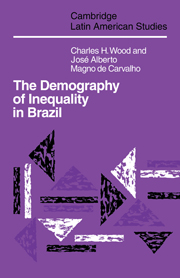Book contents
- Frontmatter
- Contents
- Illustrations
- List of tables
- Preface
- 1 Introduction
- 2 Framework for the study of population, development and inequality
- 3 Growth and distribution in historical perspective
- 4 Income inequality and length of life
- 5 Wage policy, infant mortality and collective social action in São Paulo
- 6 Racial inequality and child mortality
- 7 The “baby bust”
- 8 Income distribution and population growth
- 9 Agrarian structure and the rural exodus
- 10 Colonization and frontier expansion in Amazônia
- 11 Development and persistent underemployment
- 12 The demography of inequality in Brazil: summary and conclusion
- Appendix: A note on method
- Notes
- Bibliography
- Index
- CAMBRIDGE LATIN AMERICAN STUDIES
Appendix: A note on method
Published online by Cambridge University Press: 04 August 2010
- Frontmatter
- Contents
- Illustrations
- List of tables
- Preface
- 1 Introduction
- 2 Framework for the study of population, development and inequality
- 3 Growth and distribution in historical perspective
- 4 Income inequality and length of life
- 5 Wage policy, infant mortality and collective social action in São Paulo
- 6 Racial inequality and child mortality
- 7 The “baby bust”
- 8 Income distribution and population growth
- 9 Agrarian structure and the rural exodus
- 10 Colonization and frontier expansion in Amazônia
- 11 Development and persistent underemployment
- 12 The demography of inequality in Brazil: summary and conclusion
- Appendix: A note on method
- Notes
- Bibliography
- Index
- CAMBRIDGE LATIN AMERICAN STUDIES
Summary
Fertility
The registration of vital events in Brazil is far from complete. Although the quality of the vital registration system has greatly improved in recent years, a reliable record of the number of births in the country is still lacking. The absence of data precludes the use of conventional demographic methods that rely on vital registration statistics. Instead, we derive fertility estimates using the indirect method developed by William Brass (1968).
The Brass method requires two kinds of information, classified by the age of women: (1) the number of live births during the twelve months before the census date (current fertility), and (2) the total number of live births (retrospective fertility, or parity). Working with theoretical fertility distributions, Brass developed a series of multipliers to convert cumulated fertility into a measure of mean parity. The correction factors reflect the curvature of an underlying set of model agespecific fertility patterns. The appropriate model (and hence the multipliers) is selected by either of two summary measures derived from the data: the mean age of the fertility schedule, or the steepness of the take-off of the fertility curve (measured by the ratio of current fertility or of mean parity among women aged 15–19 to that of women 20–24 years old).
Under ideal conditions the cumulated fertility distribution of a given cohort of women should exactly match the mean parity of the same group.
- Type
- Chapter
- Information
- The Demography of Inequality in Brazil , pp. 261 - 265Publisher: Cambridge University PressPrint publication year: 1988



